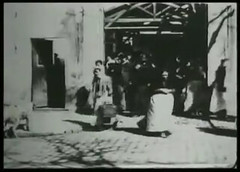Officially born in 1895, Cinema is the product of many 19th century scientific endeavors. Cinematography is the illusion of movement given by the recording and displaying of a very fast sequence of many still pictures.

image source: https://search.creativecommons.org/photos/595ac629-d9c9-4395-8500-dcece6bfa638 by vancouverfilmschool
Who invented cinema?
Nothing is known about who invented cinema. However, the Edison Company in 1891 in the United States demonstrated a prototype of the Kinetoscope, which allowed one person at a time to view moving images.


image source: https://search.creativecommons.org/photos/0ff27afb-14e0-4d79-a6b5-8bd96b8de764 by ZapMovies
Later the Lumière brothers solved the problems encountered by Edison and invented the cinématographe, a device that combines the camera with a printer and projection as well as the function of producing intermittent motion images for an audience.
The device, light and operated by a crank, allowed simultaneous viewing by several spectators.

image source: https://en.wikipedia.org/wiki/Auguste_and_Louis_Lumi%C3%A8re#/media/File:Institut_Lumi%C3%A8re_-_CINEMATOGRAPHE_Camera.jpg
Birth of Cinema
The cinema was patented in February of 1895 and a month later a short film was shown, in which workers left a factory and was considered the first film.
In the beginning, the films were very short, sometimes just a few minutes or less. They were shown in trade shows and music halls or wherever a screen and darkened room could be installed. Subjects included local scenes and activities, views of foreign lands, short plays, and events considered newsworthy.
The films were accompanied by lecturers, music and a lot of audience participation, although they did not have synchronized dialogue, they were not ‘silent’ as they are sometimes described.

Info sources:
https://blog.scienceandmediamuseum.org.uk/very-short-history-of-cinema/ https://www.britannica.com/technology/Cinematographe
